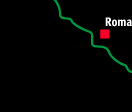|
Latium
Region
One day, while Rea Silvia, a vestal virgin,
was sleeping on the banks of the Tiber, the god Mars took
advantage of her. She gave birth to twins, Romulus and Remus,
who were brought by Acca Laurentia, known as Lupa, a woman
of easy virtue but kind heart. When the twins grew up they
went to the top of the most airy hill, the Palatine, and
decided to build a city there just for themselves, swearing
that they would kill anybody that crossed the wall marking
its boundary. Remus crossed the boundary and Romulus killed
him: it was on the 21st April 753 B.C. It was from this hill
that, seven centuries later, Augustus looked down on the
new Rome: the imperial city. We can still feel the atmosphere
of that city today when we stroll through the romantic ruins
of the Forum, the heart of the Roman Emperor: this is where,
2000 years ago, Lollia Pollinia strolled, wearing jewellery
worth a million euro; close by stands that gigantic and fascinating
circle of marble and travertine, the Coliseum: an amphitheatre
for spectacular games with animals and gladiators, where
70 thousand spectators could take their seats or leave them
in only three minutes.
Just as in the past, Rome is a city meant for spending time
out of doors: in its grand squares, like the spectacular
piazza Navona, its picturesque little marketplaces, like
Campo dei Fiori. or the noisy Sunday morning market at Porta
Portese, and in its old districts, like Trastevere, where
the charm lies in the “simple” architecture of
the houses and the maze of working-class alleyways surrounding
the square: the district is famous for its trattorie (informal
restaurants) and hosterie (taverns), where, especially in
summer, people can relive the pleasure-loving and gay atmosphere
of old Rome.
The best place to take a walk and look down on Rome from
above is the Janiculum hill: this is what the ancient Romans
and the romantic travellers of the eighteenth century did,
as well as the poets and writers of the nineteenth century
in search of inspiration. Even today, luxuriant gardens frame
the sumptuous villas of pontifical Rome, which still contain
the splendours of the past: Villa Doria Pamphili, Villa
Medici and Villa Torlonia, without forgetting the most beautiful
of all, Villa Borghese: Rome’s green heart. That heart
beats for the people too, since it became a public park in
1903. The Gallery contains very precious paintings, including
as many as 6 marvels by Caravaggio: as far as sculpture is
concerned, the Borghese Gallery is the reign of Bernini, “the
artist with the feverish look”, author of the most
splendid and impressive baroque statues in Rome.
Well, even if you do not fall in love with Rome you still
cannot escape its attraction, although you may think you
know it perfectly. And that attraction remains unchanged
on one of the oldest roads in the world: the Appian
Way;
here is where the chariots passed and the Roman soldiers
marched, on their way to conquer the empire.
Rome is not just the city of Michelangelo, the artist that,
on his own, by candlelight, crouching on a scaffold 20 metres
high, painted the beautiful damned souls in the Sistine
Chapel;
it is also the city of Caravaggio. He was known as “the
cursed painter” but the powerful Cardinal Francesco
del Monte liked him just the same. And the cardinal commissioned
the paintings we can admire in the church of San
Luigi dei Francesi, though the Curia could not forgive him for making
the saints look like common people, with dirty feet, with
chiaroscuro effects more reminiscent of taverns than of paradise.
Rome is the most elegant city in the world: nowadays, during
fashion parades, the models of Europe’s greatest couturiers
come swaying alluringly under the floodlights down the “Spanish
steps” into the piazza di Spagna, while in the Springtime
the steps are decked out with pink azaleas.
Then there is the majestic colonnade of Saint Peter’s
Square opening its arms, along with the crowds of saints
and martyrs that stand over it, to welcome in people whose
hearts are filled with faith and even people with no faith
at all.
Close to Rome there are seaside places, lakes and hills:
the tombs of the mysterious Etruscans in Tarquinia, the villas
of emperors and popes in Tivoli, Frascati and Castelgandolfo,
a sacred wood full of monsters in Bomarzo; Fregene and Ostia are popular seaside resorts. And, if it is true that all
roads lead to Rome, they can also lead on to other places:
Viterbo where you can see the fantastic papal palace, Palazzo
dei Papi, and its beautiful loggia with a gothic facade;
Sperlonga with its old town centre; the charming island of
Ponza; not to mention Fiuggi, with its spa, or beautiful
Velletri, Terracina and Gaeta. And nobody can leave this
area without tasting a dish of bucatini all’amatriciana (pasta with a spicy bacon and tomato sauce), or pajata (milk-fed
calf’s innards) or coda alla vaccinara (stewed oxtail),
washed down, of course, by a good wine from the Castelli,
the Roman hills.
For more information click on:
Lazium Region  ENTER ENTER |

|

















